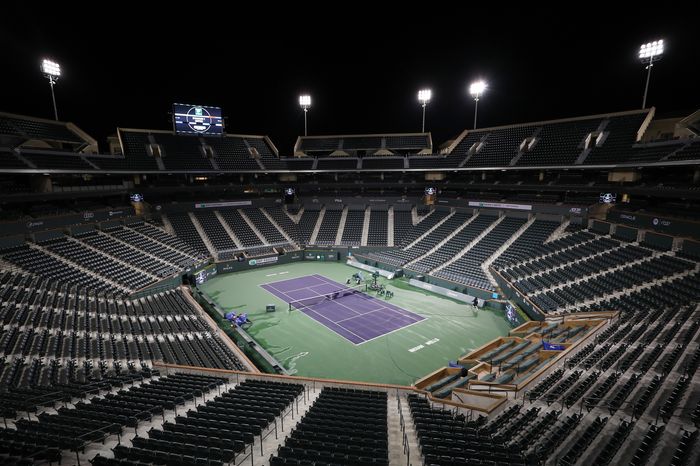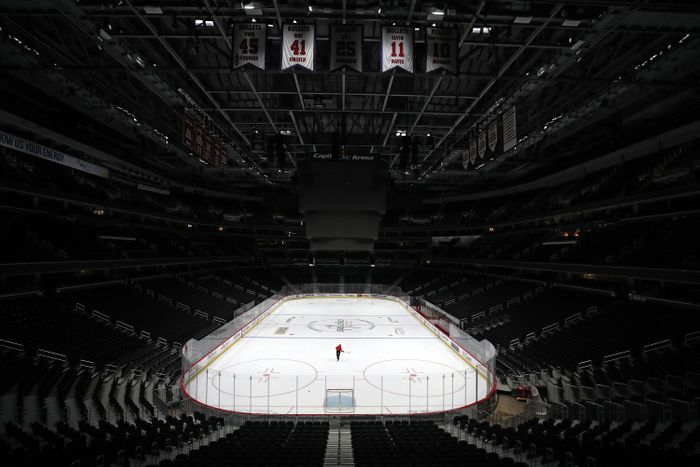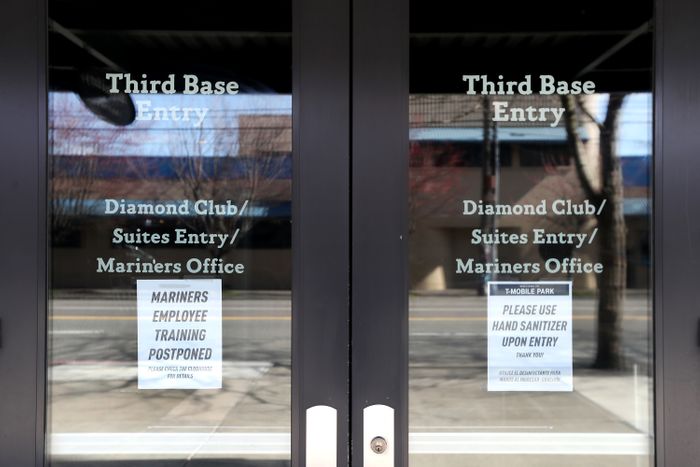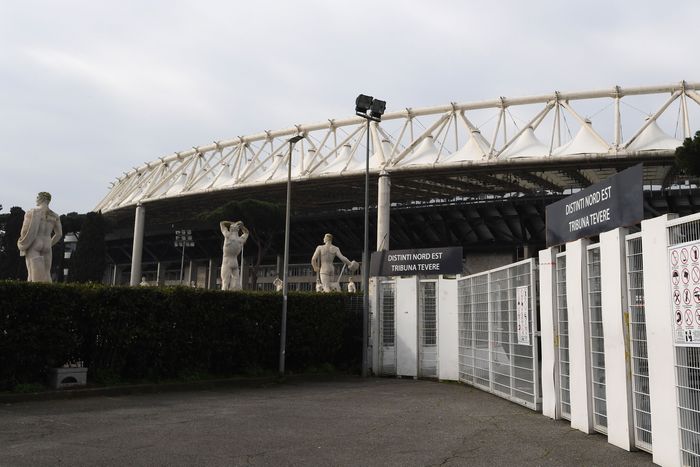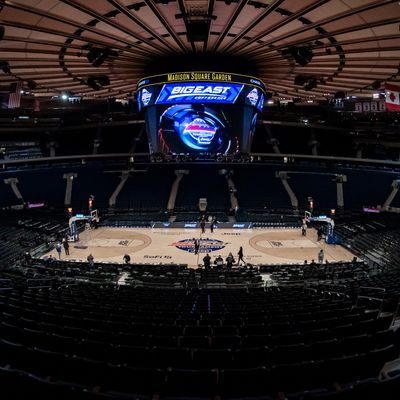
“We had antibacterial wipes everywhere,” says Jay Bilas. “Hand sanitizer. You name it.” It was last Thursday afternoon, and the longtime ESPN analyst was about to announce an Atlantic Coast Conference men’s basketball tournament game between Clemson and Florida State.
But when FSU’s players abruptly cut their pregame warm-up short, leaving the court even as the school’s band continued to play, Bilas suspected the music was about to stop. The previous night, the NBA had suspended its season shortly after Utah Jazz center Rudy Gobert tested positive for COVID-19, the novel coronavirus responsible for a global pandemic and national state of emergency.
ACC commissioner John Swofford walked onto the floor of the Greensboro Coliseum. Standing near center court, he told a group of reporters and a handful of fans who had been allowed into the building that the tournament was over, effective immediately. “After the NBA’s decision, none of us believed there was any way the ACC Tournament could go on,” Bilas says. “I recall feeling, This is tone-deaf, man. This feels wrong. I think I even said that on the air. I knew it couldn’t go on.”
From March Madness to Major League Baseball, auto racing to international soccer, leagues and events have been suspended, postponed, and outright canceled, all in an effort to slow the spread of the coronavirus. The result for the sports world is an abrupt and unplanned hiatus — an indefinite, all-encompassing athletic shutdown that has left ESPN, the self-proclaimed “worldwide leader in sports,” facing a vast programming void. In March and April alone, ESPN will have to replace 60 lost NBA regular season and playoff games, 28 MLS matches, the entire NCAA women’s basketball tournament, and a number of other games and events. Moreover, its extended universe of ancillary programming — radio shows, podcasts, online articles, talk shows like Pardon the Interruption, news shows such as SportsCenter, and gambling and fantasy sports content — depends heavily on games being played, points being scored, and trash being talked.
“What is going to be on the air in lieu of live sports and talking about live sports?” Bilas says. “I don’t know the answer to that. That’s above my pay grade. What I know is that everything is on hold. There’s a level of uncertainty to business being conducted that I have never seen before.”
During previous moments of national crisis, sports generally have played through, providing a welcome distraction and something akin to normalcy. At the beginning of World War II, MLB commissioner Kenesaw Mountain Landis sent a handwritten letter to President Franklin Roosevelt, asking if the sport should be suspended. FDR insisted that the games go on. Following 9/11, President George W. Bush’s emotional first pitch at Yankee Stadium before game three of the 2001 World Series was considered by many to be a moment of collective healing.
The threat of COVID-19, however, has created an urgent need for social distancing. Large crowds are potentially dangerous vectors of viral transmission. Even a basketball game of ten players and a single referee counts as a bigger gathering than the federal government currently recommends. As the country locks down, previous plans to play games and stage events in empty arenas and stadiums have been scrapped; even UFC president Dana White, who staged a fan-free fight in Brazil on Saturday after claiming that President Trump advised him to “live your life and stop panicking” has since reversed course.
That UFC fight, unsurprisingly, was shown on ESPN. It likely will be the company’s last broadcast of a live athletic competition for the foreseeable future. The NBA has announced that its suspension will last a minimum of 30 days. MLB doesn’t expect to resume play until at least mid-May. Those time frames increasingly appear optimistic. The Centers for Disease Control and Prevention is urging a nationwide halt to gatherings of more than 50 people for the next eight weeks; meanwhile, Trump said on Monday that the coronavirus outbreak could extend into August.
ESPN spent a reported $8 billion for live sports rights in 2017. The company has nine cable channels and a streaming service, which adds up to over 200 hours of daily programming. During the week of February 23, ESPN and ESPN2 together broadcast approximately 118 hours of live sports and event programming — mostly college basketball games, but also the NBA, the XFL, and Italian Serie A soccer — as well as 75 hours of live SportsCenter, and another 47 hours of live and same-day taped studio talk shows.
“Everything is built around live events and things happening in the moment,” says former SportsCenter anchor Jemele Hill, who now writes for The Atlantic. “This is a lot different than the typical lull in the summer. You have to survive those moments, and something always carries the narrative of those moments. But now sports is at a complete standstill. People are accustomed by habit to tune into ESPN, but if there’s nothing new to see, that’s a concern.”
As the sports world shuttered over a frantic 48-hour period last week, ESPN pivoted to breaking news, airing extended editions of SportsCenter that offered analysis and reactions from athletes, coaches, and executives. Over the weekend, the network filled in for live basketball by airing reruns of previous games and films from its 30 for 30 documentary series. “I don’t think there was an Excel spreadsheet of backup programming ready to go, but the higher-ups at the company were planning for [a disruption] a few weeks before all of the cancellations,” says a network source. “The vibe I got was to loosely be prepared.”
Nothing can replace the draw of live sports. As New York Times reporter Kevin Draper points out, none of the 50 most-watched cable programs last Friday were sports programs — whereas one week earlier, sports shows accounted for ten of the top 50, and seven of the top 15. Still, ESPN will have to air something. In a statement, executive Burke Magnus said the company has two goals: cover breaking news via live studio shows, and entertain viewers with archival content and “themed and stunt” programming. ESPN currently is covering the National Football League free agency — Tom Brady’s departure from the New England Patriots, Hill says, will produce “endless story lines, you can do that literally 24 times a day” — and the league plans to proceed with holding a modified, closed-to-the-public version of its annual draft in late April. A ten-part documentary about Michael Jordan’s final season with the Chicago Bulls that was scheduled to air in June may be moved up. Company sources say to expect more evergreen and reheated content across the board: more 30 for 30 marathons, more E:60 newsmagazine feature reruns, more top-ten lists, and more arguments over ¿quién es más macho? between Michael Jordan and LeBron James.
Will that be enough? After hosting SportsCenter last Thursday night, anchor Scott Van Pelt returned home to find an email from members of the company’s social-media team, suggesting they use the hashtag #SeniorDay as a way to celebrate high-school and college athletes whose seasons and careers were cut short. The next afternoon, Van Pelt asked his more than 2 million Twitter followers to share stories, photos, and video of those athletes, adding that “we certainly have room for some [to] join the show.” He received more than 1,000 replies, and told the Washington Post that while he “has no idea” what it will look like, he plans to spotlight some of the responses on air.
“There’s going to have to be a lot of creativity,” Hill says. “When I was there, they told us that the average viewer watched a two-to-four-minute block, turned to [another channel] during commercials, and maybe came back if you teased the next segment well enough. Now, the producers and the talent there are going to have to come up with programming that continues to meet that fix of the audience needing ESPN. If you signal to people that they can look elsewhere and live a life without you, do those fans ever come back?”
Other challenges will come as the hiatus drags on and the coronavirus crisis worsens. People in the sports world will get sick. The country will suffer. Under president Jimmy Pitaro, who took over in 2018, ESPN has steered away from content and coverage that can be seen as political, but as the company continues to cover a massive, life-and-death news story that is inescapably intertwined with rhetoric and decisions coming from Capitol Hill and the White House, sticking strictly to sports may not be possible. “Whether it’s the lack of [COVID-19] testing or the management of the situation, the last thing they need is someone wandering off and touching the third rail of political comments,” says Bob Ley, a former SportsCenter anchor and Outside the Lines host. “The more you’re on the air, the greater the potential for saying something profoundly stupid.”
ESPN is an enormous enterprise, generating more than $10 billion in annual revenue for its parent company, Disney. Still, the specter of a deep and painful economic recession looms. The loss of the rest of the NBA season alone could cost ESPN an estimated $481 million in advertising revenue, a significant figure compared to the $2.6 billion in estimated total ad revenue the company earned in 2018. “It’s on people’s minds how big of a hit this company is going to take,” says a company source. “Right now, it’s all about health and safety. All we have had is our bosses checking on everybody, asking, ‘How are you doing? Let us know if you need anything.’ They’ve been great. But at some point, the math is the math.”
In addition to covering COVID-19, people at ESPN are trying to avoid the virus. Bilas and many others who can work from home have started to do so. Daytime talk shows PTI, Around the Horn, and High Noon have been placed on hiatus; on Monday, they were replaced with reruns from that morning’s episodes of Get Up! and First Take. But programs such as SportsCenter require some people to be in their offices and on set. “Whenever there was a flu, it went around ESPN,” Hill says. “Always. I’m sure people are taking stringent precautions now, but it’s possible something could happen there like what happened to the Jazz. The bullpen for SportsCenter is a mosh of producers, production assistants, and talent all in one confined area. You can’t socially distance your way to putting on live television every day. It’s virtually impossible.”
The company has come through sudden disruption before. On the morning of 9/11, Ley was enjoying a day off, running on the treadmill in his home office in Connecticut when the first plane hit the World Trade Center’s North Tower. By the time the South Tower collapsed, he was on the phone with ESPN executive Norby Williamson. “We went speechless,” says Ley, who retired last year. “Holy shit. I said I would shave and shower and be in.”
Ley arrived at the network’s Bristol, Connecticut, headquarters by late morning. ESPN had been broadcasting ABC’s news coverage. Death tolls were rising. The country was in shock. “The question on the table was, ‘What do we do, if anything, with what is going on?’” Ley says. Opinion was split. “Some felt we had no place, that this was so far beyond sports, that it was Pearl Harbor,” Ley says. “Others felt that it was still affecting sports, and that we needed to put a historical record down.”
ESPN decided to air a single, one-hour edition of SportsCenter, hosted by Ley and Trey Wingo. At the start of the broadcast, a somber Ley told viewers that “sports is an afterthought. We fully appreciate that. We know you do as well.” For roughly a week, sports were suspended. Ley and his colleagues dutifully covered the fallout, and were ready when the games resumed. “ESPN has a proven ability to strategize through problems and react well,” he says. “Whatever they do, it will be well thought out. But it’s a huge challenge. You get through today, tomorrow. Then you have to get through April.”
Last Thursday, Bilas worked for 12 straight hours, appearing on ESPN’s various cable and radio stations as college sports went dark. He then left Greensboro and drove back to his home in Charlotte, where he has a small broadcast studio. “I’ve never worn a sport coat in my house for an entire day, but I did that on Friday,” he says of working remotely. “Saturday was the same thing.” Typically in mid-March, Bilas would be on the road, covering basketball. Not now. “The only time I’ve gone out was to help my wife with a grocery store trip and get a cup of coffee,” he says. “But otherwise, I’m doing social distancing. It’s a strange time.”
We’re committed to keeping our readers informed.
We’ve removed our paywall from essential coronavirus news stories. Become a subscriber to support our journalists. Subscribe now.
More on Coronavirus
- Andrew Cuomo Can Keep $5 Million for COVID-19 Book, Judge Rules
- Who Dares Talk Back to Patti LuPone at a Patti LuPone Talk-back?
- All Right, Which One of You Said ‘Macbeth’ in This Theater?


